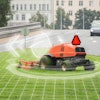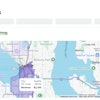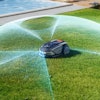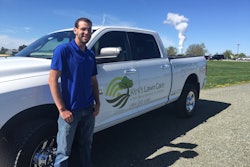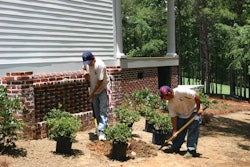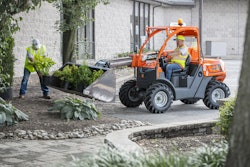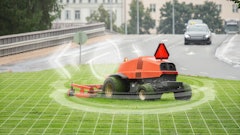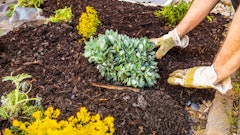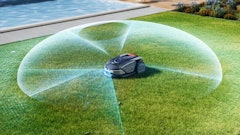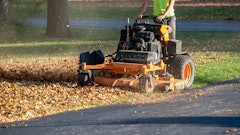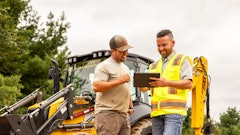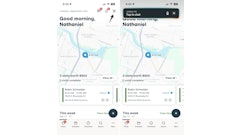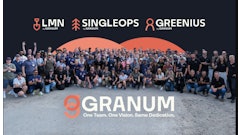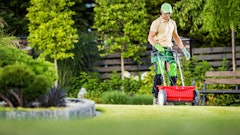
A seasoned veteran of the landscaping industry, Brandon Rushing founded Brandon Rushing Lawn and Garden Care in 1995. Today, the company has more than 70 employees and serves communities across Northern Virginia — but it wasn’t always that way.
Rushing's entrepreneurial spirit emerged early. At just 12 years old, he began his landscaping career by offering a helping hand to his neighbors. This early exposure to the industry ignited a passion that would shape his future. While pursuing his B.A. in Management at George Mason University, Rushing officially established his company at the age of 18.
 Brandon RushingBrandon Rushing Lawn & Garden Care
Brandon RushingBrandon Rushing Lawn & Garden Care
Rushing's early scripts helped manage part-time staff while balancing college classes and sports. In the mid-90s, this meant checking voicemails, returning calls, and leaving written instructions. The core idea was consistency. Every lead received a timely response. Every job had a clear scope. Every worker knew what was expected. These analog steps evolved with technology (email, CRM, video walkthroughs), but the principle remained: build a repeatable, expandable system.
This “script” wasn’t static. It evolved alongside the business, detailing everything from customer interactions to estimating practices, allowing the team to spot inefficiencies, make improvements, and train new hires. Over time, this approach became foundational: “Each process, no matter how small, is documented,” Rushing emphasized, “we can go back and revise it, improve it, and change it. And other people can pick it up, read it, learn it, and train from it.”
The Digital Transformation
While Rushing recognized the potential of integrating technology into his business early on, the path to digital adoption wasn't without its challenges. For five years, he encouraged customers to send videos, text, or pictures. Still, the response rate remained low, hovering around 25 percent, due to clients being confused by unclear instructions and complicated software. This initial hurdle highlighted the need for a more seamless digital solution.
A pivotal moment arrived in fall 2023 when Rushing made the bold pivot to exclusively virtual estimates and service calls. Rather than fighting low participation with complex solutions, they simplified the process. Customers now book through the website using a digital scheduling tool, and once scheduled, they’re prompted to upload a short walkthrough video of their property. This gives the estimator a clear, initial understanding of the site before a live video call and an easier way to document projects for future use.
This transition yielded significant benefits, with time-to-quote dramatically decreased from 3-5 days to just 1-2 days, and fuel and vehicle maintenance costs were cut by roughly 75 percent. Despite fewer human interactions, the company's close rate remained steady, and smaller service issues could now be resolved virtually through live video, eliminating unnecessary trips.
"We try to make it really easy and seamless from when the lead comes in, to when we provide them a quote, to getting started quickly."
— Brandon Rushing
How Rushing Integrated Live Video
The team at Brandon Rushing Lawn and Garden Care has integrated live video into every stage of their client engagement, from initial contact to final presentation. The process begins with customers uploading a video of their property through Rushing’s website, providing the team with a comprehensive visual overview before a live video call.
During the live video meeting, the team uses the uploaded recordings, presenting key snapshots to the client while detailing the proposed quote. To ensure accuracy, estimators use the uploaded videos as a starting point, then verify details in a live call, asking questions and requesting specific angles or measurements if needed.
Rushing sums it up simply, “We try to make it really easy and seamless from when the lead comes in, to when we provide them a quote, to getting started quickly.” This fusion of asynchronous video and synchronous video allows flexibility, detail, and real-time interaction.
Making Live Video Work for Your Company
Live video, like all technology, only reaches its full potential when a company fully embraces it. “People are hesitant if they see you are not 100 percent on board,” says Rushing. To maximize the benefits of live video, selecting the appropriate platform is crucial. Opt for user-friendly software that offers strong mobile device compatibility and features such as recording, screen sharing, and easy integration with scheduling or CRM tools.
Clear internal communication is crucial for success with live video. By establishing guidelines for when using video calls or other forms of communication, as well as keeping those meetings concise and resolute. From a recruiting perspective, the digital workflow also appeals to younger employees who value efficiency and modern tools. It also makes training more consistent, helping new hires get up to speed faster.
Best Practices to Get the Most Out of Live Video
- Encourage crews to display unexpected issues live to enable faster, more accurate problem-solving, minimize downtime, and avoid halting work.
- Utilize video for remote training sessions to demonstrate techniques and review work, making instruction more interactive and hands-on, even from a distance.
- Involve clients with scheduled video walkthroughs to keep them engaged, informed, and reduce unnecessary in-person visits.
- Record key conversations such as approvals and change orders. These visual records help avoid misunderstandings, ensure accountability, and protect your business in disputes.
While live video offers many benefits for landscaping businesses, there are challenges to consider. Connectivity issues are common on outdoor job sites due to poor cell coverage or unreliable Wi-Fi, which can interrupt video calls. Companies can mitigate this by investing in portable Wi-Fi hotspots or selecting video platforms optimized for low-bandwidth conditions.
Respecting client privacy is crucial when integrating live video into your landscaping business. Open communication and clear consent are essential, especially when recording on client property. To build comfort and trust, always discuss video recording with clients beforehand, explaining its purpose and benefits. Obtain explicit consent, whether verbal or written, and establish clear guidelines for when and how recording will occur, including sharing, access, and storage. Prioritize privacy by ensuring video is used only for its intended purpose and stored securely. By addressing these considerations, your business can leverage live video effectively while strengthening client relationships.  Brandon Rushing Lawn & Garden Care
Brandon Rushing Lawn & Garden Care
Time to Grow
Brandon Rushing’s story is a reminder that success isn’t just built on hard work, but also the courage to evolve. What began as a young boy’s neighborhood service has grown into a thriving business powered by qualified people, advancing processes, and a clear purpose. By combining clear, repeatable processes with intuitive live video technology, his team has achieved faster turnaround times, improved customer satisfaction, and positioned the company for long-term growth.
His experience offers a practical blueprint for others in the industry: build systems that are teachable and adaptable; use technology to streamline operations; and stay committed to continuous improvement. As the landscaping world becomes increasingly digital, success will favor those who lead that shift, not just by adopting new tools, but by using them to create a better, more efficient experience for both teams and clients.
